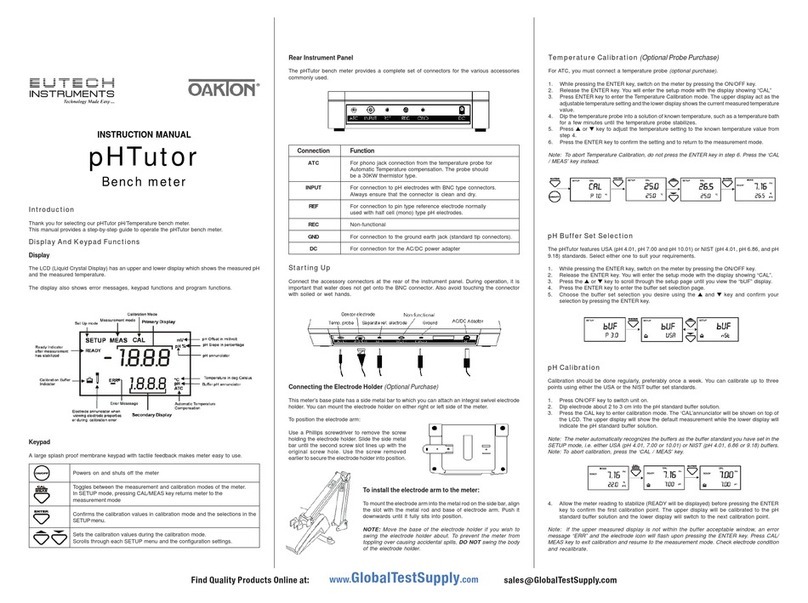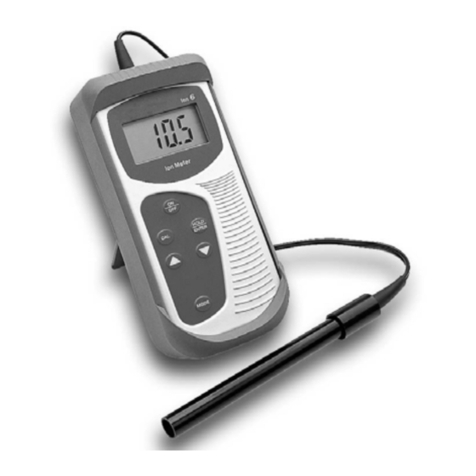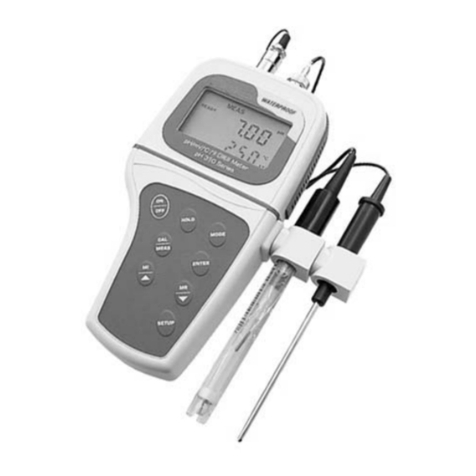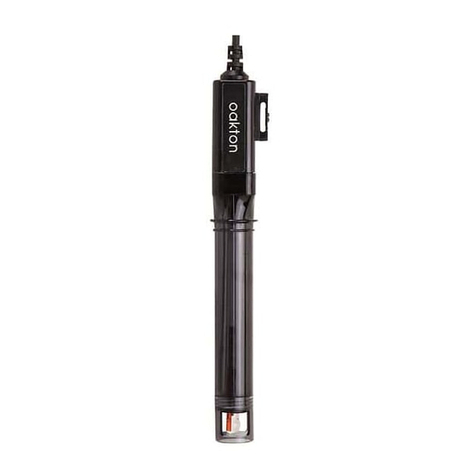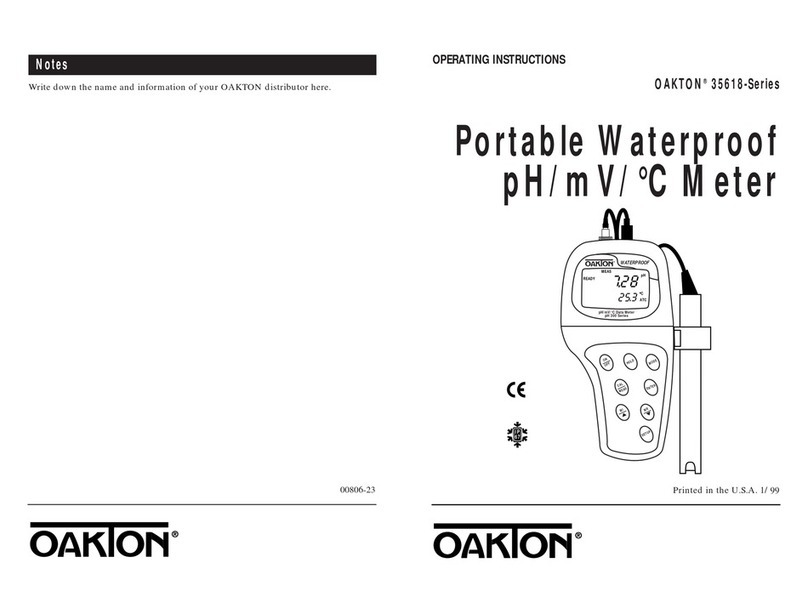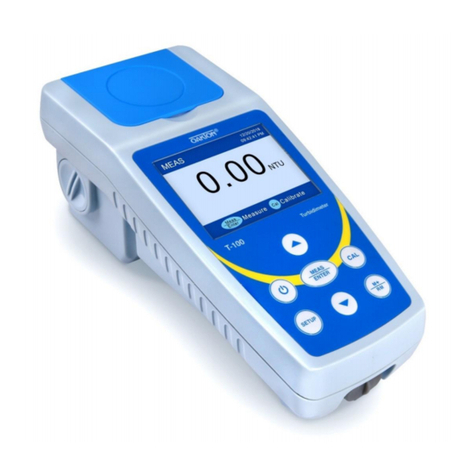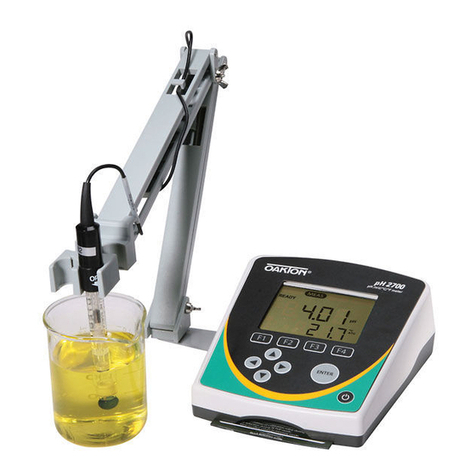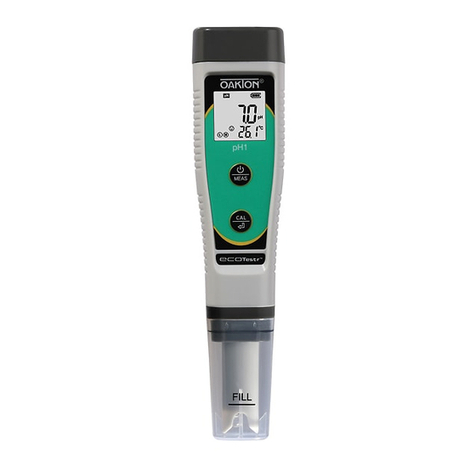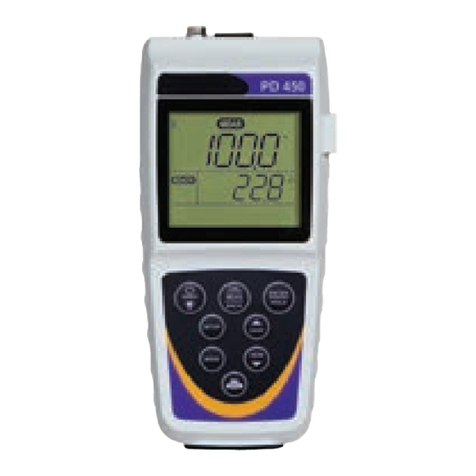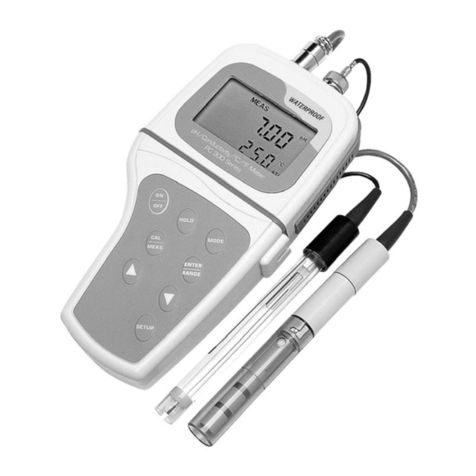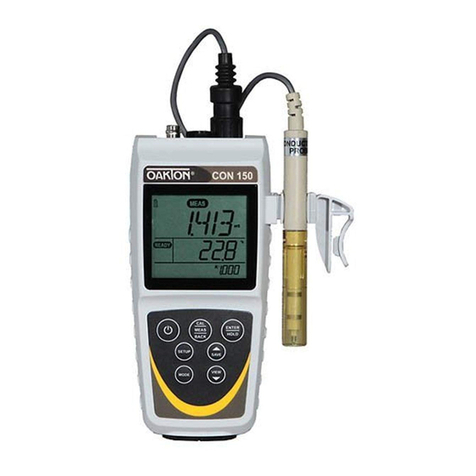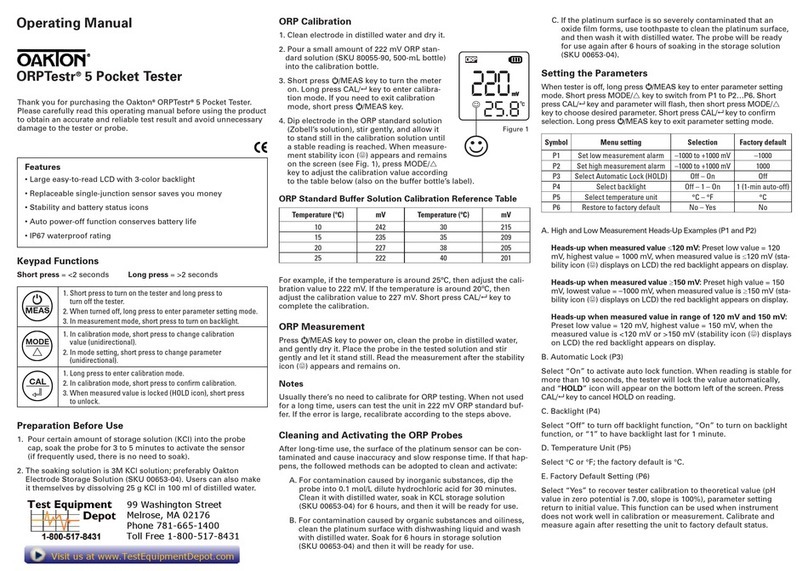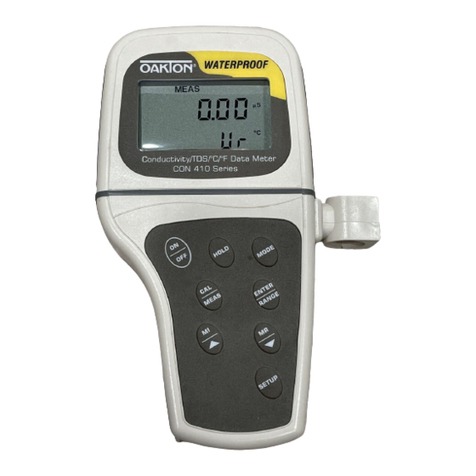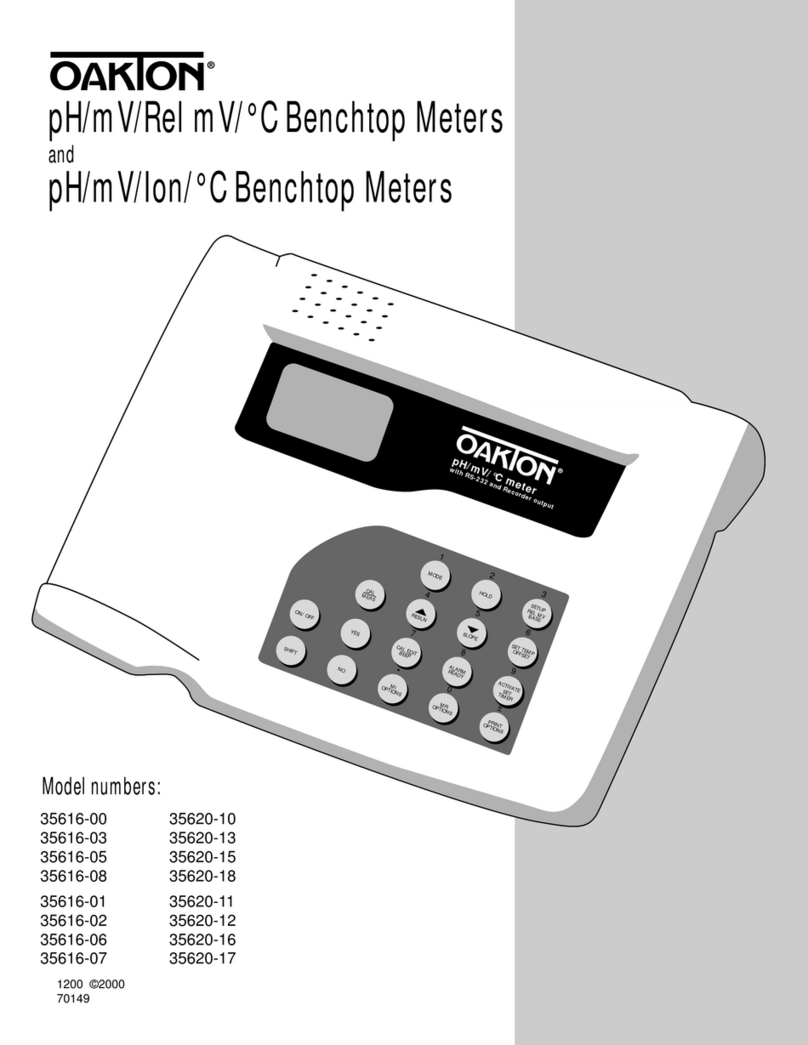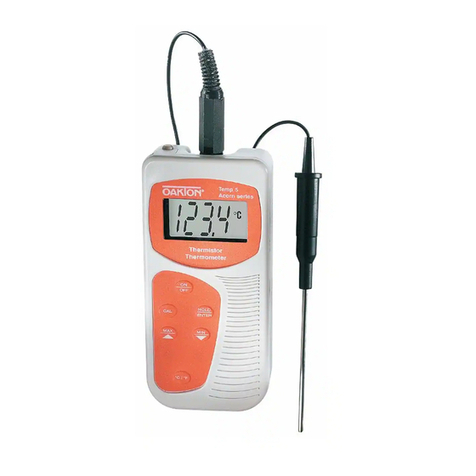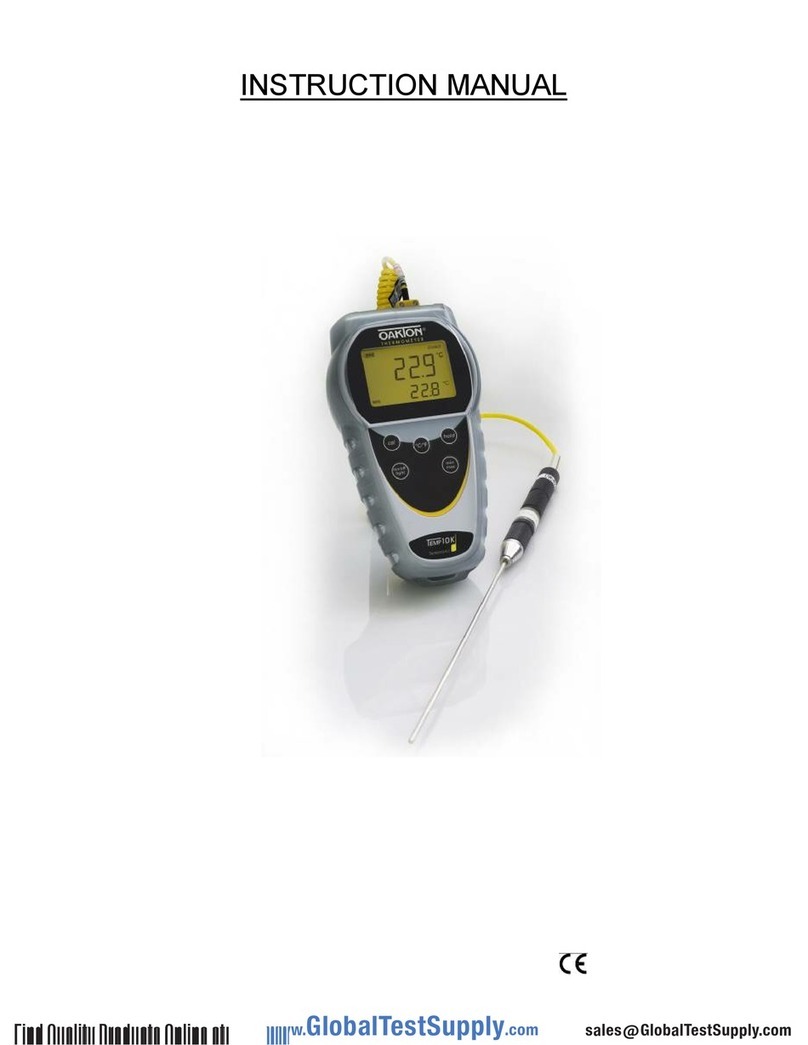Manual Calibration
In manual calibration, the tester allows 1-point calibration for each measuring range. You can
use customized calibration solutions with known conductivity/TDS values to calibrate the tester.
The following table shows acceptable conductivity/TDS ranges of calibration solutions for each
measuring range. Make sure your calibration solutions are within the given ranges.
Selected Measuring Range Acceptable Calibration Standard Range
Conductivity TDS/Salt
LO 200 - 2000 μS/cm 200 - 2000 ppm
HI 2.00 - 20.00 mS/cm 1.00 - 10.00 ppt
AUTO Select a calibration standard nearer to application sample
To prepare calibration standards:
Use fresh calibration solutions. Measure conductivity/TDS values of the solution with a meter
known to be accurate. Prepare each solution in two beakers - one for rinsing and the other for
calibration. Rinse the electrode in de-ionized water before calibration.
To begin manual calibration:
1. Switch on the tester. Make sure the tester is in measuring mode. Rinse the electrode with the
calibration standard that you intend to calibrate and then dip the electrode in the other beaker
with same calibration standard. Swirl gently to create a homogenous sample and allow time
for the reading to stabilize.
2. Press INC or DEC key to enter calibration mode. The ‘CAL’ indicator appears in LCD. The display
briefly shows ‘CAL’ and the number of points the tester will be calibrated.
3. The upper display shows the measured conductivity/TDS reading of the solution based on
previous calibration (if any) and the lower display shows the default (uncalibrated) conductivi-
ty/TDS reading.
Note: The tester shows error message ‘Er.1’ :
(a) If the reading is over range (Or) of selected measuring range of the tester , or
(b) If the default (uncalibrated) reading is not within the acceptable calibration standard ran-
ge.
Use INC and DEC keys to adjust the upper display to the correct conductivity/TDS value of the
calibration solution.
Note: The calibration adjustment window is ± 50% from the default reading.
Note: If you do not press INC or DEC key within 5 seconds, the tester shows the confirmation
‘CO’ and returns to the measurement mode. However, the tester is not calibrated to new values
yet. The old calibration is still active. If this happens, press INC or DEC key once again to enter
calibration mode.
4. Wait for 5 seconds for the tester to automatically confirm the calibration by displaying ‘CO’
and return to the measurement mode.
Note: To exit calibration mode without confirming the calibration, press HOLD/ENT key before
the automatic confirmation takes place.
Note: The tester shows error message ‘Er.0’ and returns to measuring mode if the temperature
of the calibration solution is not within 0°C to 50°C.
5. For multi-point calibration rinse the electrode in de-ionized water and repeat step the above
steps with another standard solution.
TDS Factor Setting
TDS factor is only applicable for TDSTester11 models. The factory default TDS factor is 0.71. You
can adjust the TDS factor to suit different samples of your applications.
To change TDS factor:
1. Switch on the tester. Make sure the tester in measurement mode. Press HOLD key to bring
the tester to the HOLD mode.
2. Press INC or DEC key to enter the TDS factor setting mode.
3. The upper & lower displays of LCD show the last configured TDS factor. The upper display is
adjustable. Use the INC or DEC key to adjust the TDS factor.
The adjustable range is 0.4 to 1.0
Note: If you do not press INC or DEC key within 5 seconds, the tester shows the confirmation
‘CO’ and returns to measurement mode.
4. Wait for 5 seconds for the tester to automatically confirm the new setting by displaying ‘CO’
and return to the measurement mode.
Temperature Calibration
Temperature calibration need not be performed every time, unless the temperature reading
differs from that of an accurate thermometer. If temperature calibration is performed, Conduc-
tivity/TDS/Salt calibration is mandatory.
1. Switch on the tester. Make sure the tester is in measuring mode. If required, press °C/°F key
to select the desired unit of measurement for temperature (Celsius or Fahrenheit). Dip the tester
into a solution of known temperature and allow time for the temperature reading to stabilize.
2. Press INC or DEC key to bring the tester to the calibration mode. CAL’ indicator appears in
LCD. Immediately press °C/°F key to switch to the temperature calibration mode.
Note: When you enter calibration mode, if the conductivity/TDS/salt reading is outside the
specified range (Or), the tester shows ‘Er.1’ error message. You can still proceed to the tempe-
rature calibration mode by pressing °C/°F key immediately. If the °C/°F key is not pressed within
2 seconds, the tester exits the calibration mode and returns to the measurement mode.
3. The upper display shows the measured temperature reading based on the last set offset
(if any) and the lower display shows the default (uncalibrated) temperature reading based on
factory y settings. Use INC and DEC keys to adjust the upper temperature reading to the known
temperature value of the solution.
Notes: The temperature adjustment window is ± 5°C (± 9°F) from the default reading.
4. Wait for 5 seconds for the tester to automatically confirm the temperature calibration value
by displaying ‘CO’ and return to the measurement mode.
Note: To exit temperature calibration mode without confirming the calibration, press °C/°F key
or HOLD/ENT key before the automatic confirmation takes place.
Note: The tester shows error message ‘Er.0’ and returns to measuring mode if the temperature
of the solution is not within 0°C to 50°C.
Reset
Reset option allows you to restore the calibration and other parameters back to factory default
settings.
1. Switch off the tester. Press and hold the HOLD key and then switch on the tester using ON/OFF
key. Release HOLD key.
2. The lower display shows ‘rSt’ (reset) and the upper display blinks ‘No’. Use INC or DEC key
to select ‘Yes’ (to proceed with resting) or ‘No’ (to quit without resetting).
Note: Press °C/°F key if you wish to skip to measurement mode without making any selec-
tion.
3. Press HOLD key to confirm your selection. LCD shows ‘CO’. If ‘Yes’ is selected, the tester
resets to its factory default values as listed below. LCD shows power-up sequence and tester
goes to measurement mode.
Parameter Factory Default
User calibration (conductivity/TDS/salt) (Reset)
Temperature unit of measurement Celsius (°C)
Temperature offset 0
Auto calibration (for ECTester11) Enable
1-point calibration Enable
Conductivity calibration factor (for ECTester11) 1.0
TDS factor (for TDSTester11) 0.71
Changing Batteries
Replace the batteries when the low battery indicator starts blinking.
1. Open the battery compartment lid (with attached lanyard loop).
2. Remove old batteries by pulling plastic ribbon.
Replace with fresh ones.
Figure 11: Battery compartment
Electrode Maintenance
1. Always keep the sensor electrodes clean. Rinse the electrodes with de-ionized water and wipe
them dry with clean cloth before storing with its protective cap.
Model ECTester11
19 46 81
TDSTester11
19 47 01
SALTTester11
19 47 11
Range: Lo
Hi
0 to 2000 μS/cm
0 to 20.00 mS/cm
0 to 2000 μS/cm
0 to 10.00 mS/cm
-
0 to 10.00 ppt
Resolution: Lo
Hi
10 μS/cm
0.10 mS/cm
10 ppm
0.10 ppt
-
0.10 ppt
Accuracy ± 1% of Full Scale
Calibration Type Auto or Manual Manual Manual
Calibration Points 1 or 2 points 1 or 2 points 1 point
Calibration Window ± 50% from each point
Calibration Standard
Range (Manual) Lo
Hi
200 - 2000 μS/cm .
2.00 - 20.00 mS/cm
200 - 2000 ppm .
1.00 - 10.00 ppt
-
1.00 - 10.00 ppt
Sensor Type Two-pin
TDS Factor 0.4 to 1.0 (Default 0.71)
Temperature
Range in °C
Range in °F
Resolution
Accuracy
Calibration point
Calibration Window
ATC
Temp Coefficient
0.0 to 50.0°C
32.0 to 122°F
0.1°C (0.1°F)
±0.5°C (±0.9°F)
1 point
± 5°C (± 9°F)from factory default
0 to 50°C
2% per °C
Normalization Temp 25.0°C
Auto Off 8.5 minutes after last key press
Operating Temp 0 to 50°C
Power Battery 4 X 1.5V”A76“ micro alkaline battery
Battery Life >150 hrs
LCD Display Custom Dual Display 27mm (H) X 21 mm (W)
Dimensions, Weight Tester: 16.5 cm X 3.8 cm; 90g
Boxed: 22cm X 6cmX 5cm; 170 g
For cup type electrodes, remove the white
plastic cup and insert to thoroughly clean
viscous solutions. Never scratch electrodes
with a hard substance.
2. For better performance, soak the electrode
in alcohol for 10 to 15 minutes and rinse
with de-ionized water before starting any
measurement process.
This is to remove dirt and oil stains on the
electrode which may affect the accuracy of
the measurements.
Electrode Replacement
When the tester fails to calibrate or gives
fluctuating readings in calibration standards,
you need to change the electrode module. You
can replace the electrode module at a fraction
of the cost of a new tester.
1. With dry hands, grip the ribbed tester collar
with electrode facing you. Twist the collar
counter clockwise (see Figure13-A). Save the
ribbed tester collar and O-ring for later use.
2. Pull the old electrode module away from
the tester.
3. Align the four tabs of the new electrode
module so that they match the four slots on
the tester (see Figure 13-B).
4. Gently push the module into the slots to sit
it in position. Push the smaller O-ring fully onto
the new electrode module. Push the collar over
the module and thread it into place by firmly
twisting clockwise.
Note: It is necessary that you recalibrate the
tester prior to measurement after an electrode
replacement.
Accessories
194716 Replacement Sensor MicroDirect
EC/TDS/SALT11
Warranty
The waterproof testers are warranted to be
free from manufacturing defects for 2 years
and electrode module for 12 months, unless
otherwise specified. If repair, adjustment or
replacement is necessary and has not been
the result of abuse or misuse within the time
period specified, please return the tester -
freight prepaid - and correction will be made
without charge. Out of warranty products will
be repaired on a charge basis.
Return of Items
Authorization must be obtained from your
distributor before returning items for any re-
ason. When applying for authorization, please
include information regarding the reason the
item(s) are to be returned.
Note: Tintometer reserve the right to make
improvements in design, construction and
appearance of products without notice. Prices
are subject to change without notice.
Technical changes without notice
Printed in Germany 07/11
